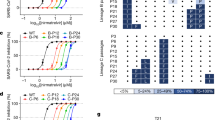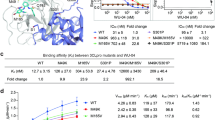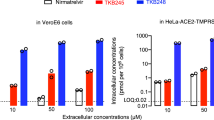Abstract
Nirmatrelvir is a specific antiviral drug that targets the main protease (Mpro) of SARS-CoV-2 and has been approved to treat COVID-191,2. As an RNA virus characterized by high mutation rates, whether SARS-CoV-2 will develop resistance to nirmatrelvir is a question of concern. Our previous studies have shown that several mutational pathways confer resistance to nirmatrelvir, but some result in a loss of viral replicative fitness, which is then compensated for by additional alterations3. The molecular mechanisms for this observed resistance are unknown. Here we combined biochemical and structural methods to demonstrate that alterations at the substrate-binding pocket of Mpro can allow SARS-CoV-2 to develop resistance to nirmatrelvir in two distinct ways. Comprehensive studies of the structures of 14 Mpro mutants in complex with drugs or substrate revealed that alterations at the S1 and S4 subsites substantially decreased the level of inhibitor binding, whereas alterations at the S2 and S4′ subsites unexpectedly increased protease activity. Both mechanisms contributed to nirmatrelvir resistance, with the latter compensating for the loss in enzymatic activity of the former, which in turn accounted for the restoration of viral replicative fitness, as observed previously3. Such a profile was also observed for ensitrelvir, another clinically relevant Mpro inhibitor. These results shed light on the mechanisms by which SARS-CoV-2 evolves to develop resistance to the current generation of protease inhibitors and provide the basis for the design of next-generation Mpro inhibitors.
This is a preview of subscription content, access via your institution
Access options
Access Nature and 54 other Nature Portfolio journals
Get Nature+, our best-value online-access subscription
$29.99 / 30 days
cancel any time
Subscribe to this journal
Receive 51 print issues and online access
$199.00 per year
only $3.90 per issue
Buy this article
- Purchase on Springer Link
- Instant access to full article PDF
Prices may be subject to local taxes which are calculated during checkout





Similar content being viewed by others
Data availability
All experimental data are provided in the manuscript. The structures determined in this study have been deposited to the PDB under accession codes: 8HBK (WT–ensitrelvir), 8H6N (T21I–nirmatrelvir), 8H7W (S144A–nirmatrelvir), 8H82 (E166V–nirmatrelvir), 8H4Y (F140L–nirmatrelvir), 8H57 (A193P–nirmatrelvir), 8H5F (L167F–nirmatrelvir), 8H51 (T21I/E166V–nirmatrelvir), 8H5P (L50F/E166V–nirmatrelvir), 8H3G (E166V–ensitrelvir), 8H3L (T21I/E166V–ensitrelvir), 8H3K (L50F/E166V–ensitrelvir), 8H7K (H41A/T21I–nsp4 | 5) and 8H6I (L50F/E166V–oridonin). The structures of the Mpro–nirmatrelvir, H41A–nsp4|5 and Mpro–oridonin complexes were downloaded from PDB under the accession codes 7VH8, 7DVP and 7VIC, respectively. Materials used in this study will be made available under an appropriate Materials Transfer Agreement. Source data are provided with this paper.
Code availability
No code was used for this study.
References
Owen, D. R. et al. An oral SARS-CoV-2 Mpro inhibitor clinical candidate for the treatment of COVID-19. Science 374, 1586–1593 (2021).
Hammond, J. et al. Oral nirmatrelvir for high-risk, nonhospitalized adults with Covid-19. New Engl. J. Med. 386, 1397–1408 (2022).
Iketani, S. et al. Multiple pathways for SARS-CoV-2 resistance to nirmatrelvir. Nature https://doi.org/10.1038/s41586-022-05514-2 (2022).
Wang, Q. et al. Antibody evasion by SARS-CoV-2 Omicron subvariants BA.2.12.1, BA.4 and BA.5. Nature https://doi.org/10.1038/s41586-022-05053-w (2022).
Wong, C. K. H. et al. Real-world effectiveness of early molnupiravir or nirmatrelvir–ritonavir in hospitalised patients with COVID-19 without supplemental oxygen requirement on admission during Hong Kong’s omicron BA.2 wave: a retrospective cohort study. Lancet Infect. Dis. https://doi.org/10.1016/S1473-3099(22)00507-2 (2022).
Takashita, E. et al. Efficacy of antibodies and antiviral drugs against Omicron BA.2.12.1, BA.4, and BA.5 subvariants. N. Engl. J. Med. 387, 468–470 (2022).
Charness, M. E. et al. Rebound of SARS-CoV-2 infection after nirmatrelvir-ritonavir treatment. N. Engl. J. Med. 387, 1045–1047 (2022).
Anderson, A. S., Caubel, P. & Rusnak, J. M. Nirmatrelvir-ritonavir and viral load rebound in Covid-19. N. Engl. J. Med. 387, 1047–1049 (2022).
Girardin, F., Manuel, O., Marzolini, C. & Buclin, T. Evaluating the risk of drug-drug interactions with pharmacokinetic boosters: the case of ritonavir-enhanced nirmatrelvir to prevent severe COVID-19. Clin. Microbiol. Infect. 28, 1044–1046 (2022).
Zhao, Y. et al. Structural basis for replicase polyprotein cleavage and substrate specificity of main protease from SARS-CoV-2. Proc. Natl Acad. Sci. USA 119, e2117142119 (2022).
Zhao, Y. et al. Crystal structure of SARS-CoV-2 main protease in complex with protease inhibitor PF-07321332. Protein Cell 13, 689–693 (2022).
Jin, Z. et al. Structure of Mpro from SARS-CoV-2 and discovery of its inhibitors. Nature 582, 289–293 (2020).
Clavel, F. & Hance, A. J. HIV drug resistance. N. Engl. J. Med. 350, 1023–1035 (2004).
Labrie, M., Brugge, J. S., Mills, G. B. & Zervantonakis, I. K. Therapy resistance: opportunities created by adaptive responses to targeted therapies in cancer. Nat. Rev. Cancer 22, 323–339 (2022).
Corey, L. et al. SARS-CoV-2 variants in patients with immunosuppression. New Engl. J. Med. 385, 562–566 (2021).
Harari, S. et al. Drivers of adaptive evolution during chronic SARS-CoV-2 infections. Nat. Med. 28, 1501–1508 (2022).
Heyer, A. et al. Remdesivir-induced emergence of SARS-CoV2 variants in patients with prolonged infection. Cell Rep. Med. 3, 100735 (2022).
Hogan, J. I. et al. Remdesivir resistance in transplant recipients with persistent coronavirus disease 2019. Clin. Infect. Dis. 76, 342–345 (2023).
Gandhi, S. et al. De novo emergence of a remdesivir resistance mutation during treatment of persistent SARS-CoV-2 infection in an immunocompromised patient: a case report. Nat. Commun. 13, 1547 (2022).
Martinot, M. et al. Emerging RNA-dependent RNA polymerase mutation in a remdesivir-treated B-cell immunodeficient patient with protracted coronavirus disease 2019. Clin. Infect. Dis. 73, e1762–e1765 (2021).
Shu, Y. & McCauley, J. GISAID: Global Initiative on Sharing All Influenza Data - from vision to reality. Eurosurveillance 22, 30494 (2017).
Xocova® (ensitrelvir fumaric acid) tablets 125mg approved in Japan for the treatment of SARS-COV-2 infection, under the Emergency Regulatory Approval System. Shionogi https://www.shionogi.com/global/en/news/2022/11/e20221122.html (2022).
Unoh, Y. et al. Discovery of S-217622, a noncovalent oral SARS-CoV-2 3CL protease inhibitor clinical candidate for treating COVID-19. J. Med. Chem. 65, 6499–6512 (2022).
Mukae, H. et al. A randomized phase 2/3 study of ensitrelvir, a novel oral SARS-CoV-2 3C-like protease inhibitor, in Japanese patients with mild-to-moderate COVID-19 or asymptomatic SARS-CoV-2 infection: results of the phase 2a part. Antimicrob. Agents Chemother. 66, e0069722 (2022).
Cao, Y. et al. BA.2.12.1, BA.4 and BA.5 escape antibodies elicited by Omicron infection. Nature https://doi.org/10.1038/s41586-022-04980-y (2022).
Liu, L. et al. Striking antibody evasion manifested by the Omicron variant of SARS-CoV-2. Nature 602, 676–681 (2022).
Lu, L. et al. Neutralization of severe acute respiratory syndrome coronavirus 2 Omicron variant by sera from BNT162b2 or CoronaVac vaccine recipients. Clin. Infect. Dis. 75, e822–e826 (2022).
Halfon, P. & Locarnini, S. Hepatitis C virus resistance to protease inhibitors. J. Hepatol. 55, 192–206 (2011).
Zhong, B. et al. Oridonin inhibits SARS-CoV-2 by targeting Its 3C-like protease. Small Sci. 2, 2270012 (2022).
Xue, X. et al. Production of authentic SARS-CoV Mpro with enhanced activity: application as a novel Tag-cleavage endopeptidase for protein overproduction. J. Mol. Biol. 366, 965–975 (2007).
Kabsch, W. XDS. Acta Crystallogr. D 66, 125–132 (2010).
McCoy, A. J. et al. Phaser crystallographic software. J. Appl. Crystallogr. 40, 658–674 (2007).
Emsley, P., Lohkamp, B., Scott, W. G. & Cowtan, K. Features and development of Coot. Acta Crystallogr. D 66, 486–501 (2010).
Afonine, P. V. et al. Towards automated crystallographic structure refinement with phenix.refine. Acta Crystallogr. D 68, 352–367 (2012).
Liu, H. et al. Development of optimized drug-like small molecule inhibitors of the SARS-CoV-2 3CL protease for treatment of COVID-19. Nat. Commun. 13, 1891 (2022).
Ye, C. et al. Rescue of SARS-CoV-2 from a single bacterial artificial chromosome. mBio 11, e02168-20 (2020).
Acknowledgements
We acknowledge the Discovery Technology Platform of the Shanghai Institute for Advanced Immunochemical Studies and the Molecular and Cell Biology Core Facility of the School of Life Science and Technology, ShanghaiTech University for use of their instrumentation and technical assistance; and the staff members from beamlines BL02U1, BL10U2, BL18U1 and BL19U1 at the Shanghai Synchrotron Radiation Facility and the I04 beamline of the Diamond Light Source for the beam time and operation at the facility. This work was supported by grants from Guangzhou Laboratory (grant numbers SRPG22-003 and SRPG22-011); the Science and Technology Commission of Shanghai Municipality (grant numbers YDZX20213100001556 and 20XD1422900 to H.Y.); the National Natural Science Foundation of China (grant number 92169109 to H.Y.); and the Shanghai Frontiers Science Center for Biomacromolecules and Precision Medicine of ShanghaiTech University. A.C. is supported by a Career Award for Medical Scientists from the Burroughs Wellcome Fund.
Author information
Authors and Affiliations
Contributions
H.Y. and D.D.H. conceived this project. Y.D., H.Z., X.Z., Q.B., H.S., Y.Z., X.L. and Y.L. cloned, expressed, purified and crystallized proteins. Y.D., M.L. and H.Z. collected the diffraction data. X.L., M.L. and H.W. solved the crystal structures. Y.D., X.Z., H.Z. and Q.B. carried out enzymatic activity and inhibition assays. S.I. conducted live virus assays. S.I., S.J.H., B.C., H.M., M.I.L., Y.S. and A.C. generated recombinant SARS-CoV-2. Z.R., S.P.G. and X.Y. contributed to discussions of the data and analysis. K.Y., X.L., Y.D., S.I., D.D.H. and H.Y. wrote the manuscript with input from all authors.
Corresponding authors
Ethics declarations
Competing interests
S.I., A.C. and D.D.H. are inventors on patent applications related to the development of inhibitors against the SARS-CoV-2 3CL protease. D.D.H. is a co-founder of TaiMed Biologics and RenBio, consultant to WuXi Biologics and Brii Biosciences, and board director for Vicarious Surgical.
Peer review
Peer review information
Nature thanks Charles Craik and the other, anonymous, reviewer(s) for their contribution to the peer review of this work.
Additional information
Publisher’s note Springer Nature remains neutral with regard to jurisdictional claims in published maps and institutional affiliations.
Extended data figures and tables
Extended Data Fig. 1 Dose-response curves of nirmatrelvir and ensitrelvir inhibiting Mpros.
Curves of each compound inhibiting 8 Mpros are sorted into 3 groups based on the location of the substitutions. a, Dose-response curves of nirmatrelvir inhibiting E166V, F140L, and S144A. b, Dose-response curves of nirmatrelvir inhibiting T21I, T21I/E166V, and L50F/E166V. c, Dose-response curves of nirmatrelvir inhibiting L167F and A193P. d, Dose-response curves of ensitrelvir inhibiting E166V, F140L, and S144A. e, Dose-response curves of ensitrelvir inhibiting T21I, T21I/E166V, and L50F/E166V. f, Dose-response curves of ensitrelvir inhibiting L167F and A193P. Dose-response curves of nirmatrelvir or ensitrelvir inhibiting WT Mpro are also shown in these panels. Data points are shown as mean ± SD for biological quadruplicates. Note that for panels c and f, the curves of L167F and A193P are overlapping very closely with each other.
Extended Data Fig. 2 Structure of H41A/T21I in complex with nsp4 | 5 peptide substrate.
a, Protomer A of H41A/T21I is shown as marine cartoon (protomer B not shown), nsp4 | 5 peptide is shown as hot pink sticks, water is shown as a marine sphere, the Fo-Fc omit-map shown as the green mesh is contoured at 2.4σ. b, Mpro forms a homodimer and protomer B is colored orange. c, The surface of H41A/T21I protomer B is shown as white surface (protomer A not shown). d-e, Hydrogen bond network between nsp4 | 5 and residues from H41A or H41A/T21I mutant. The P6-P2′ portion of the nsp4 | 5 substrate is not shown, P3′-P4′ portion is colored black and P5′ is colored grey because P5′ could not be traced in the electron density map. Residues of the H41A mutant that form hydrogen bonds with nsp4 | 5 are represented in grey squares, and residues of the H41A/T21I mutant are represented in marine squares. Hydrophobic interaction is shown as an arc with spokes. Water molecules are shown as red circles. Hydrogen bonds are shown as marine dashes and the lengths of hydrogen bonds are indicated in the metric unit of angstrom.
Extended Data Fig. 3 Overlay of WT Mpro-nirmatrelvir complex structure and T21I-nirmatrelvir complex structure (a) or T21I/E166V-nirmatrelvir complex structure (b).
Protomer A of WT Mpro is colored white and protomer B of WT Mpro is colored black, nirmatrelvir in WT Mpro-nirmatrelvir complex structure is shown as green sticks, protomer A of the mutant structure is colored marine and protomer B of the mutant structure is colored orange, nirmatrelvir in mutant Mpro-nirmatrelvir complex structure is shown as red sticks.
Extended Data Fig. 4 Overlays of Mpro-ensitrelvir complex structures.
a, Overlay of WT Mpro-ensitrelvir and E166V-ensitrelvir complex structures; protomer A of WT Mpro is colored white and protomer B of WT Mpro is colored black, ensitrelvir in WT Mpro-ensitrelvir complex structure is shown as green sticks, protomer A of E166V mutant is colored marine and protomer B of E166V mutant is colored orange, ensitrelvir in E166V-ensitrelvir complex structure is salmon colored. This panel shows the catalytic pocket of protomer B. b, Overlay of WT Mpro-ensitrelvir and T21I/E166V-ensitrelvir complex structures. Protomer A of WT Mpro is colored white and protomer B of WT Mpro is colored black, ensitrelvir in WT Mpro-ensitrelvir complex structure is shown as green sticks, protomer A of T21I/E166V mutant is colored marine and protomer B of T21I/E166V mutant is colored orange, ensitrelvir in T21I/E166V-ensitrelvir complex structure is salmon colored. c, Overlay of WT Mpro-ensitrelvir and L50F/E166V-ensitrelvir complex structures. Protomer A of WT Mpro is colored white and protomer B of WT Mpro is colored black, ensitrelvir in WT Mpro-ensitrelvir complex structure is shown as green sticks, protomer A of L50F/E166V mutant is colored marine and protomer B of L50F/E166V mutant is colored orange, ensitrelvir in L50F/E166V-ensitrelvir complex structure is salmon colored. π-cation interaction and hydrogen bond are shown as black dashes and their lengths are indicated in angstroms. Structural comparisons of double mutants with E166V single mutant are not shown because no significant differences could be observed around the substitution points.
Extended Data Fig. 5 Structure of L50F/E166V in complexes with oridonin and oridonin-inhibition data.
a, Overlay of WT Mpro-oridonin (PDB ID: 7VIC) and L50F/E166V-oridonin complex structures, WT Mpro is colored white, L50F/E166V mutant is colored marine. Oridonin in complex with WT Mpro is colored green, and the oridonin in complex with L50F/E166V is colored purple. Hydrogen bonds are shown as black dashes and their lengths are indicated in angstroms. b, Oridonin-inhibition data in enzymatic assays and cell-based assays, values are shown as fold change in IC50 value relative to inhibition of the WT Mpro by oridonin and fold change in EC50 relative to inhibition of the WT virus by oridonin. c, Representative curves for inhibition of recombinant SARS-CoV-2 carrying Mpro substitutions, data points are shown as mean ± standard error of the mean (SEM) for three technical replicates, EC50 values are given as mean ± SD for two biologically independent experiments. d-f, Dose-response curves of oridonin inhibiting Mpros in enzymatic assays, data points are shown as mean ± SD for four biologically independent replicates; d, Dose-response curves of oridonin inhibiting F140L, S144A, and E166V; e, Dose-response curves of oridonin inhibiting L167F and A193P; f, Dose-response curves of oridonin inhibiting T21I, T21I/E166V, and L50F/E166V.
Supplementary information
Supplementary Information
Supplementary Fig. 1 and Tables 1 and 2.
Rights and permissions
Springer Nature or its licensor (e.g. a society or other partner) holds exclusive rights to this article under a publishing agreement with the author(s) or other rightsholder(s); author self-archiving of the accepted manuscript version of this article is solely governed by the terms of such publishing agreement and applicable law.
About this article
Cite this article
Duan, Y., Zhou, H., Liu, X. et al. Molecular mechanisms of SARS-CoV-2 resistance to nirmatrelvir. Nature 622, 376–382 (2023). https://doi.org/10.1038/s41586-023-06609-0
Received:
Accepted:
Published:
Issue Date:
DOI: https://doi.org/10.1038/s41586-023-06609-0
This article is cited by
-
Resistance mechanisms of SARS-CoV-2 3CLpro to the non-covalent inhibitor WU-04
Cell Discovery (2024)
-
The biosafety level-2 macromolecular crystallography beamline (BL10U2) at the Shanghai Synchrotron Radiation Facility
Nuclear Science and Techniques (2023)
Comments
By submitting a comment you agree to abide by our Terms and Community Guidelines. If you find something abusive or that does not comply with our terms or guidelines please flag it as inappropriate.



